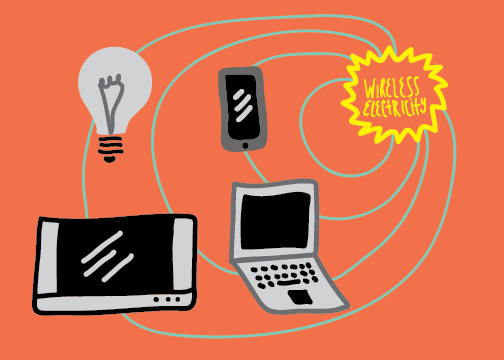No cords necessary

Wireless energy transfer allows devices to be charged without the use of wires or cords
April 7, 2014
Chargers and cords can be unplugged and tossed as wireless energy transfer is becoming better able to serve consumers.
Marin Soljačić, a physics professor at the Massachusetts Institute of Technology, began developing wireless energy because he was tired of being awakened by his wife’s cell phone alerting her about a low battery charge. Over the past six years, the work of Soljačić and a team of MIT researchers and engineers has led to their establishing of a wireless electricity company called WiTricity.
The team began studying the efficiency of wireless electricity in 2005, developing the technology to power a 60 W lightbulb from several meters away without the use of a cord in 2007. Several years later, the team developed WiTricity power sources for devices such as computers and radios, according to Kaynam Hedayat, vice president of marketing and product management for WiTricity.
Hedayat said the technology behind WiTricity’s wireless energy is called magnetic resonance, which occurs when an electrical source generates a magnetic field using coils while another coil device resonates at the same frequency. This allows electromagnetic waves to be transferred across mid-range distances of one centimeter to several meters, which can then be used for energy.
“Our goal is to eliminate every power cord and also eliminate the need to use any disposable battery … allowing people to be able to recharge their batteries wirelessly,” Hedayat said.
Hedayat said Toyota recently announced it would incorporate WiTricity’s technology into a new wireless hybrid vehicle set to hit the market in 2016, adding that smaller electronic devices equipped with the wireless technology to improve battery life will be released later this year.
“The small devices [today] have nice capabilities but they don’t have enough energy resources,” said Cenk Gursoy, associate professor in the Department of Electrical Engineering and Computer Science at Syracruse University.
Nikola Tesla, a mechanical engineer, created the idea of wireless energy 120 years ago, Hedayat said. Gursoy said Tesla wanted to transfer wireless energy to power street lamps without using cables.
However, the wireless technology was primarily limited by distance, according to Duane Bucheger, professor of Practice, Electrical and Computer Engineering at Michigan Technological University. Bucheger said transferring wireless energy requires large electromagnetic fields. While some energy can be transmitted, Bucheger said, wireless energy transfers may not be strong enough to produce a significant amount of power.
Hedayat said traditional wireless power transfers require close proximity between devices. But WiTricity’s technology overcame this problem by producing wireless energy that could transfer across a greater distance.
Although Bucheger is not against the wireless technology improvements, they do come with safety concerns, adding that the safety of wireless electricity ultimately depends on the strength of the electromagnetic field because a strong enough field could cause cancer.
Hedayat said WiTricity’s technology meets the safety criteria of organizations such as the Society for Technical Communication and the Institute of Electrical and Electronics Engineers.
Gursoy said people are already surrounded by wireless transmissions, such as wireless signals from smartphones and WiFi systems.
WiTricity has also helped to develop a wireless heart pump—known as the left ventricle assist device—which helps heart patients awaiting a transplant maintain a steady heartbeat, Hedayat said. He said earlier versions of the device required a wire to stick out of the patient’s stomach.
The danger was not the pump’s functionality but the possibility that the wire itself could cause infection, Hedayat said, adding that wireless versions could help eliminate the possibility of infection.
“Basically every device will have a standard wireless electricity technology in [it] and every one will work inversely, similar to WiFi,” Hedayat said.







